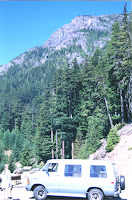Okay, so the children thought my husband and I were crazy one evening in the camper when we said we would visit a rain forest the next day.
“Mom,” our second daughter—the Brainiac—informed me from her perch on the bunk. “We are in the northern half of the continental U. S.”
“Yea, Washington State,” our son clarified from his burrow on the dinette seat cushions.
 |
| Olympic Nat’l Park in Washington State is vast. Not many inroads. Need to drive to trailheads. |
Like we didn’t know where we were after driving almost 3,000 miles across the whole United States from New Jersey.
“Yes,” I said, “but this particular rain forest is actually in Washington State.”
My husband burst out laughing after a few moments. When I glared at him, he nodded toward the children. They were giving me that “poor, silly mom” look I get whenever I ask a computer question.
A grin creased my face. Just wait until tomorrow, my angels. Then we’ll see who doesn’t know what she’s talking about.
 |
| Temperate rain forest of the Hoh River in Olympic National Park. |
The Hoh Rain Forest is part of the huge Olympic National Park system in Washington State. We like to take part in the park ranger programs after watching the informative video at the Visitor’s Center. On our Hall of Mosses ranger-led hike into the rain forest, a 0.8 mile loop, we not only heard facts about the rain forest, we discovered how to identify a huge tree from a legend.
The Hoh Rain Forest is a temperate rainforest, one of the finest left in the Pacific Northwest rainforest region. I didn’t realize that there were two kinds of rain forests. The children were thinking of the tropical rain forests by the equator that they had learned about in school. I must admit; I didn’t know our U.S. rain forest was of the temperate kind, which means it’s not as hot and steamy as the tropical kind. I was happy about this. I was envisioning the sweltering kind myself when my husband and I first talked about visiting Hoh Rain Forest.
The Hoh Rain Forest can get up to 14 feet of rain a year. My bones started aching just from the thought of all that rain! Amazingly, we had a dry hike. Temperate rainforests don’t get extremely hot or extremely cold for very long.
We hiked through a dense forest of deciduous [leaf-bearing] and coniferous [evergreen] trees. Our United States rain forest just dripped in moss and broad leaves and huge ferns. These big trees with their leaves and pine needles trap the moisture coming inland from the coast. As we stopped by yet another huge conifer tree, a Douglas fir, our ranger offered some facts about it.
“These fir trees can grow about 535 inches in circumference,” the park ranger told us. “And scrape the sky at 213 feet high.”
A smile tugged at my lips. I covered it with my hand. I didn’t feel it was right to remind the ranger—for I was sure he knew—that the Sequoia and Redwood trees in California were taller and larger in circumference. My husband saw my smile and elbowed me. He probably knew what I was thinking.
I’m supposed to learn something new wherever I go, I told myself. So listen. I did, and discovered something unique about these huge trees.
“The Douglas fir pine cone has a strange story.” The park ranger looked at us. “Legend has it that at one time you could find hundreds of mice scurrying about in the rain forest.”
“Mice?” I whispered to my husband. He shushed me.
“Long, long ago,” the ranger began. “There lived a tiny mouse in the forest. This mouse loved the huge pine forest out west as did his many relatives. But they all were fearful day and night, for the sly fox always tried to catch them and gobble them up.
“Now this particular mouse was very clever, though, and was able to hide from the fox for a long, long time. But one day, the mouse’s attention wandered as he walked among the huge Douglas fir trees in the forest. Before he knew it, the fox had snuck up on him and he was face to face with his enemy!
“The mouse was terrified and ran off as fast as he could. But he knew the fox was faster and much bigger than he was. Frantically the mouse searched for a place to hide. Then he spied a Douglas fir pine cone hanging on a tall tree. The mouse thought it was large enough to hide him, so he scurried up the tree and tried to squeeze inside the cone.”
The ranger had us all wide-eyed and concerned for this poor little mouse.
“Well,” the ranger continued. “The mouse was hidden well enough that the fox couldn’t find him.”
I breathed a sigh of relief, not realizing that I didn’t want to hear a story—or legend—about a fox devouring a tiny mouse.
“But,” the ranger said as he picked up one of the Douglas fir pine cones from the rain forest floor. “The pine cone really was way too small for the mouse.” He showed everyone the cone.
| To this day, those little mice still scurry under the scales of a Douglas fir pine cone. |
“And to this day, you can still see the hind legs and tail of the mouse sticking out from the Douglas fir pine cone, where he is still hiding from the fox.”
Not only did we learn a lot about rain forests, when we visited Hoh Rain Forest, we now know how to identify a Douglas fir evergreen, or coniferous tree. Although our Douglas firs on the East Coast don’t get as big as the ones out west, we still find a few mouse tail cones here in New Jersey. Do you have any Douglas fir trees where you live? Just look for the back end of a mouse hanging out of the pine cones.
Thanks so much for visiting Camping with Five Kids. Please follow my blog if you haven’t already. We’d love to hear any nature legends you may have learned or hear about your visit to a national park in the comments section. We truly appreciate your note.

We went there this past summer! We loved it!
https://onceuponatimeinhaz.blogspot.com/2017/08/pnw-adventures-hoh-rainforest.html
Thank you so much, Morgan, for your comment on Camping with Five Kids. I truly appreciate it. And thanks for your link. I visited to read and comment on your post. Looks like you had an awesome time, too. Love the photos!
Thanks again for your note on Camping with Five Kids. Enjoy your weekend!
Hi Victoria Marie – what a lovely post … with a ranger who was totally engaged with his world … loved reading it – bet you all remember certain (and no doubt all) parts of the visit – thanks … I did so enjoy it (I'll adapt bits for the A-Z) – cheers Hilary
Thank you for your kind words, Hilary! We certainly enjoyed our visit to a real live rainforest. And yes, we'll remember it for sure. It's always a pleasure seeing you here at Camping with Five Kids. Enjoy your weekend!
Love this one. Thanks again.
Hello and welcome to Camping with Five Kids. I truly appreciate your kind words. Thank you! All the best to you.
That's so cool. I didn't know about the "mouse tails" in the pine cones. I'll have to look for them the next time I see a Douglas Fir pine cone. Great post!
Thank you so much, Michelle, for your kind words. They are greatly appreciated. We found the mouse tail cones extremely helpful in identifying the Douglas Fir tree. We learn so much from the park rangers at national and state parks.
It's always a pleasure seeing you here at Camping with Five Kids, Michelle. Enjoy your week!
3000 mile drive! Wow, I don't fly that far for holidays. And 14 foot of rain, we only average just under a foot in the UK and we think that's bad.
Driving and camping to our many hiking adventures are how we can afford to travel with five kids, Bill. Yes, it was amazing that we had a beautiful day for the ranger-led hike into a rain forest.
I'm hoping you are well. It's always a pleasure seeing you here at Camping with Five Kids. Enjoy your weekend!
Awesome! We’re looking forward your blog
clipping path service
Hello and welcome to Camping with Five Kids! Thank you so much for your kind words. I’ll hop over to visit your blog.
I post on Camping with Five Kids once a month and look forward to your visiting again. Enjoy your week!
Nice post.Keep sharing. Thanks
clipping path service provider
Nice post.
http://www.23hq.com/ayanrajput/a/about